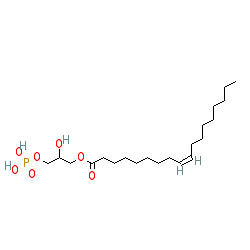GtoPdb is requesting financial support from commercial users. Please see our sustainability page for more information.
|
Synonyms: 1-oleoyl-LPA | lysophosphatidic acid
Compound class:
Metabolite
Comment: LPA is small biogenic and endogenous phospholipid derivative in mammals which acts as a potent signaling molecule
Ligand Activity Visualisation ChartsThese are box plot that provide a unique visualisation, summarising all the activity data for a ligand taken from ChEMBL and GtoPdb across multiple targets and species. Click on a plot to see the median, interquartile range, low and high data points. A value of zero indicates that no data are available. A separate chart is created for each target, and where possible the algorithm tries to merge ChEMBL and GtoPdb targets by matching them on name and UniProt accession, for each available species. However, please note that inconsistency in naming of targets may lead to data for the same target being reported across multiple charts. ✖ |
|
|||||||||||||||||||||||||||||||||||
| References |
|
1. An S, Bleu T, Hallmark OG, Goetzl EJ. (1998)
Characterization of a novel subtype of human G protein-coupled receptor for lysophosphatidic acid. J Biol Chem, 273 (14): 7906-10. [PMID:9525886] |
|
2. Bandoh K, Aoki J, Hosono H, Kobayashi S, Kobayashi T, Murakami-Murofushi K, Tsujimoto M, Arai H, Inoue K. (1999)
Molecular cloning and characterization of a novel human G-protein-coupled receptor, EDG7, for lysophosphatidic acid. J Biol Chem, 274 (39): 27776-85. [PMID:10488122] |
|
3. Clair T, Aoki J, Koh E, Bandle RW, Nam SW, Ptaszynska MM, Mills GB, Schiffmann E, Liotta LA, Stracke ML. (2003)
Autotaxin hydrolyzes sphingosylphosphorylcholine to produce the regulator of migration, sphingosine-1-phosphate. Cancer Res, 63 (17): 5446-53. [PMID:14500380] |
|
4. Dubin AE, Herr DR, Chun J. (2010)
Diversity of lysophosphatidic acid receptor-mediated intracellular calcium signaling in early cortical neurogenesis. J Neurosci, 30 (21): 7300-9. [PMID:20505096] |
|
5. Hecht JH, Weiner JA, Post SR, Chun J. (1996)
Ventricular zone gene-1 (vzg-1) encodes a lysophosphatidic acid receptor expressed in neurogenic regions of the developing cerebral cortex. J Cell Biol, 135 (4): 1071-83. [PMID:8922387] |
|
6. Im DS, Heise CE, Harding MA, George SR, O'Dowd BF, Theodorescu D, Lynch KR. (2000)
Molecular cloning and characterization of a lysophosphatidic acid receptor, Edg-7, expressed in prostate. Mol Pharmacol, 57 (4): 753-9. [PMID:10727522] |
|
7. Kano K, Arima N, Ohgami M, Aoki J. (2008)
LPA and its analogs-attractive tools for elucidation of LPA biology and drug development. Curr Med Chem, 15 (21): 2122-31. [PMID:18781939] |
|
8. Kotarsky K, Boketoft A, Bristulf J, Nilsson NE, Norberg A, Hansson S, Owman C, Sillard R, Leeb-Lundberg LM, Olde B. (2006)
Lysophosphatidic acid binds to and activates GPR92, a G protein-coupled receptor highly expressed in gastrointestinal lymphocytes. J Pharmacol Exp Ther, 318 (2): 619-28. [PMID:16651401] |
|
9. Lu Y, Wang Z, Li CM, Chen J, Dalton JT, Li W, Miller DD. (2010)
Synthesis, in vitro structure-activity relationship, and in vivo studies of 2-arylthiazolidine-4-carboxylic acid amides as anticancer agents. Bioorg Med Chem, 18 (2): 477-95. [PMID:20056548] |
|
10. Murakami M, Shiraishi A, Tabata K, Fujita N. (2008)
Identification of the orphan GPCR, P2Y(10) receptor as the sphingosine-1-phosphate and lysophosphatidic acid receptor. Biochem Biophys Res Commun, 371 (4): 707-12. [PMID:18466763] |
|
11. Noguchi K, Ishii S, Shimizu T. (2003)
Identification of p2y9/GPR23 as a novel G protein-coupled receptor for lysophosphatidic acid, structurally distant from the Edg family. J Biol Chem, 278 (28): 25600-6. [PMID:12724320] |
|
12. Oh DY, Yoon JM, Moon MJ, Hwang JI, Choe H, Lee JY, Kim JI, Kim S, Rhim H, O'Dell DK, Walker JM, Na HS, Lee MG, Kwon HB, Kim K, Seong JY. (2008)
Identification of farnesyl pyrophosphate and N-arachidonylglycine as endogenous ligands for GPR92. J Biol Chem, 283 (30): 21054-64. [PMID:18499677] |
|
13. Pasternack SM, von Kügelgen I, Aboud KA, Lee YA, Rüschendorf F, Voss K, Hillmer AM, Molderings GJ, Franz T, Ramirez A, Nürnberg P, Nöthen MM, Betz RC. (2008)
G protein-coupled receptor P2Y5 and its ligand LPA are involved in maintenance of human hair growth. Nat Genet, 40 (3): 329-34. [PMID:18297070] |
|
14. Santos WL, Heasley BH, Jarosz R, Carter KM, Lynch KR, Macdonald TL. (2004)
Synthesis and biological evaluation of phosphonic and thiophosphoric acid derivatives of lysophosphatidic acid. Bioorg Med Chem Lett, 14 (13): 3473-6. [PMID:15177455] |
|
15. Southern C, Cook JM, Neetoo-Isseljee Z, Taylor DL, Kettleborough CA, Merritt A, Bassoni DL, Raab WJ, Quinn E, Wehrman TS et al.. (2013)
Screening β-Arrestin Recruitment for the Identification of Natural Ligands for Orphan G-Protein-Coupled Receptors. J Biomol Screen, 18 (5): 599-609. [PMID:23396314] |
|
16. Tabata K, Baba K, Shiraishi A, Ito M, Fujita N. (2007)
The orphan GPCR GPR87 was deorphanized and shown to be a lysophosphatidic acid receptor. Biochem Biophys Res Commun, 363 (3): 861-6. [PMID:17905198] |
|
17. Yanagida K, Masago K, Nakanishi H, Kihara Y, Hamano F, Tajima Y, Taguchi R, Shimizu T, Ishii S. (2009)
Identification and characterization of a novel lysophosphatidic acid receptor, p2y5/LPA6. J Biol Chem, 284 (26): 17731-41. [PMID:19386608] |







